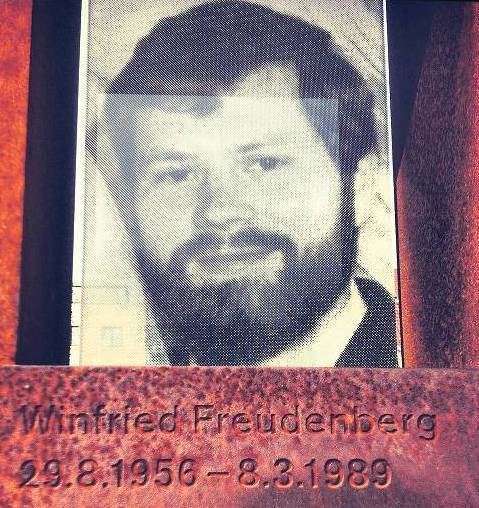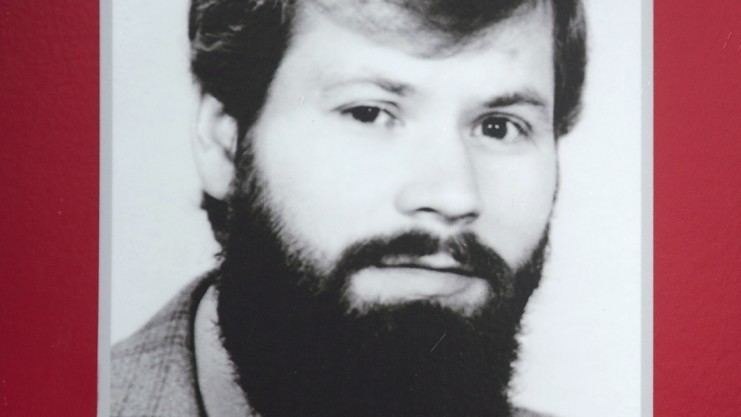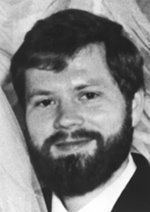Name Winfried Freudenberg | ||
 | ||
Cause of death Home-made gas balloon crash whilst attempting to leave East Berlin52°25′47″N 13°13′26″E / 52.4297°N 13.2239°E / 52.4297; 13.2239 (Empty balloon found in branches of a tree) Body discovered Backyard of a garden villa in Zehlendorf52°26′01″N 13°15′38″E / 52.4336°N 13.2606°E / 52.4336; 13.2606 (Vicinity of Winfried Freudenberg crash site) Died March 8, 1989, West Berlin | ||
Winfried Freudenberg (29 August 1956 – 8 March 1989) was the last person to die in an attempt to escape from East Germany to West Berlin across the Berlin Wall as he fell from an improvised gas balloon at high altitude over West Berlin.
Contents

Biography

Freudenberg was born in Osterwieck, and grew up in the Saxony-Anhalt town of Lüttgenrode, near what was then the border between his native East Germany, which was then a part of the communist Eastern Bloc, as a satellite state of the Soviet Union, and West Germany. After completing an apprenticeship as electrician, he obtained his secondary education diploma in night school, then trained in information technology, receiving a diploma as electronics engineer. In the autumn of 1988 he married his wife Sabine, a chemist he had met while both were students at Ilmenau University. East Germany cutting them off from the professional opportunities that existed in the West, the couple, especially Winfried, had become increasingly disappointed about being unable to cross the border. Immediately after the wedding the two began planning their escape to the west by a homemade balloon filled with natural gas (because its main component, methane, is lighter than air, natural gas can serve as a lifting gas).
Escape and Death

As part of their plan, Freudenberg took a job in a public utility also supplying natural gas, and the two took an apartment in the East Berlin neighborhood of Prenzlauer Berg. In January and February 1989, they began assembling a 13 metre tall by 11 metre diameter balloon envelope out of polythene, which they cut into strips, taped together, and engirded with a string net. There was no basket, only a narrow wooden beam. On the evening of 7 March they decided that the wind conditions were favourable for their escape. They drove to a pressure regulating station in Blankenburg neighborhood to which Freudenberg had the keys and at midnight began to fill their balloon with gas. From some time after 1:00 am the balloon was visible from a distance. A waiter on his way home from work which had ended at 1:30 am noticed the balloon, and called the Volkspolizei. When the couple heard a patrol car arriving shortly after 2:00 am the balloon was not yet completely filled. Because they feared it would not lift both of them they quickly decided for Freudenberg to escape alone, his wife always having been doubtful. He occupied the beam and cut the tethers. With only one person aboard the balloon had a very high buoyancy and rose fast. Ballast bags hanging down on lines severed a power line shortly after launching and caused it to short-cut and spark. Although East German security had often shot and killed citizens attempting to escape, they decided against shooting because of the possibility of triggering an explosion of the natural gas now leaking. Also, they believed Freudenberg to have been killed by the current which was not the case. Freudenberg's 23 year old wife was able to get back home, where the Stasi were already waiting for her.

However, with the balloon having much too much buoyancy, it rose much faster, and, because there was no properly working valve in the improvised balloon, much higher than planned. Freudenberg couldn't sink and spent more than five hours aloft. At first the course was west-south-west. With wind velocities of about 20 km/h at the time he must have reached West Berlin after about 20 minutes. Later Freudenberg passed over the Berlin Tegel Airport where he lost or dropped some ballast. His altitude must at this point have increased to more than 2,000 meters (6,500 feet), as his course now changed to south due to different direction of higher altitude winds. The balloon was sighted over Teufelsberg hill at dawn and held for a weather balloon. Shortly before flying into East German territory again, at 7:30 in the morning Freudenberg fell into the garden of a villa in the suburb of Zehlendorf. The remains of the balloon came down about one kilometer away on the median strip of a thoroughfare. Freudenberg's body was discovered only hours later. He evidently died instantly from injuries sustained in the crash. Nearly every bone in his body had been broken and virtually every internal organ had been damaged. The direct cause of the crash is not clear. West Berlin police supposed that Freudenberg climbed the net to cut the envelope in which he obviously succeded, and in the ensuing events lost his hold.
After the incident, East German police investigated the friends, family, acquaintances, and colleagues of Freudenberg and his wife, to determine whether any had participated in the escape attempt. Because of international attention and pressure over the recent shooting over Chris Gueffroy, the last refugee to be shot by East German border guards, Sabine Freudenberg was given the relatively lenient sentence of three years of probation, and then granted amnesty in October 1989. The next month East Germany began allowing its citizens to travel to the west, and several months later the Berlin Wall was dismantled and the two countries reunified.
